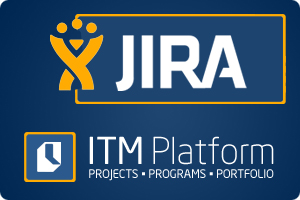We talk to Sander about our JIRA connector, the last product update on ITM Platform that produces a complete vision of development processes from the project management perspective.

Question: Can you tell us a little bit about how the project was born?
Sander: We already knew JIRA as a big actor in the industry of project management, but in this case we had a particular customer in Spain who was using JIRA regularly, and for them an integration with ITM Platform became a very important element. The starter of the project was that a customer asked for this piece, but besides that we immediately recognized that it would be an interesting enhancement for other customers as well, so the decision to include the integration was quickly taken.
Q: What sector is the company in?
S: They’re in logistics, but we talked to their IT Department. In a way, that corresponds very accurately to the general scenario that we are targeting with the enhancement: a business core that relies very heavily on the integration of information processes into the daily delivery of services will very likely benefit from the combined strengths of JIRA, on the IT side, and ITM Platform on the project management side.
"With the new connector, PPMs can combine the day-to-day view in JIRA with the general overview provided by ITM Platform"
Q: What does the connector do?
S: The connector establishes a link between Atlassian JIRA and ITM Platform and it helps you to synchronize any projects and issues on JIRA to ITM Platform. You can select which projects and issues you want to synchronize so you can decide to keep certain projects only in JIRA and to have all project information available on ITM Platform. Apart from projects, it also synchronizes human resources, issues and people on those issues.
"The connector allows to sync JIRA projects as the three types of projects on ITM Platform: classic, Kanban and services"
Q: Did you find any major obstacles in development?
S: I wouldn’t say that we had any major obstacles, because JIRA is a very well established product, they encourage integrations and they have solid documentation to do this.
That said, of course we had some minor issues that are more related to design decisions and terminology than to actual problems in writing the code. The type of information on both systems is different and we had to design a way to match it. For example, we decided that an issue on JIRA would be a task on ITM Platform, which was reasonable because both entities are quite limited and are subordinated to projects. However, we then realized that customers can have issues on JIRA with no end date, while this is a mandatory field on ITM Platform. We had to think of functional ways to work around this and fix it.
One of the other things that we realized during development is that companies may have many different types of projects, even from entirely different business areas, and in many cases it wouldn’t make sense to synchronize all of this to ITM Platform. That’s the reason we decided to include filters so customers can decide which projects and issues to sync, and which not.
Q: When taking these decisions, did you have in mind the customer that asked for the integration, or a long term strategy of how people are going to use this?
S: I guess you could say we were thinking from both perspectives. We considered how would this project actually make sense for any customer in the market, but in the meantime we shared intermediate designs with the customer to make sure they would be satisfied with it, which was the case.
That said, we made sure to move beyond the scope of this specific customer, who works a lot with gantt chart, waterfall and classic project management, to make sure other customers could decide to sync their JIRA projects and issues onto the three types of project entities supported by ITM Platform: besides classic projects, there’s also Kanban projects and services. In that sense, we foresaw future usage beyond the initial scope.
For instance, you can perfectly imagine to manage a service on ITM Platform, but that the issues identified are managed on JIRA. The synchronization can then be configured to obtain a complete overview of the service that includes the resolution of the issues.
Q: Why is the connector important and who do you think will benefit the most?
S: If we look at users within organizations, people responsible for planning projects at the program or portfolio level will benefit the most, because they will have the day-to-day management for issues on JIRA and the full overview that ITM Platform allows without having to work on two systems or manually copying information. This can be very important in understanding how resources are being utilized, as some of them might be assigned to small JIRA issues and at the same time to larger projects.
Q: What can you build on top of the information pushed from JIRA?
S: Any additional information that does not come from JIRA can be managed on ITM Platform. A good example is the budget, which is not driven by JIRA.
Q: How does this connection fit into ITM Platform’s strategic vision?
S: It fits within our vision that we should be an open system. We want to be able to serve many different companies and we are aware that companies already use other systems and many different tools. These are the things that need to be able to work together with ITM Platform. JIRA is an example but there are also financial, accounting, or ERP systems that companies use to manage their day to day operations, like for example their order process. The need to integrate those systems with ITM Platform is why we’ve already built a very extensive library of APIs.
We’re constantly looking forward to enabling integrations with other systems, either through open APIs or through specific integrations like the one we did with JIRA.
"Our vision is to be an open product that any company can integrate with their legacy systems"
Q: Are you currently working on any other similar improvements?
S: Yes, we are doing an integration with Slack that is focused on team members, who will be able to do all the basic actions they can perform on ITM platform.
They can see what projects and tasks they are assigned to, they can leave follow-ups, they can comment on tasks, they can report their hours, etc. And they can do all that by just chatting, even from their phone. It’s an interesting trend that we’re seeing more and more: chatboxes are replacing traditional interfaces.
We’re not pretending to completely replace our solution with Slack, because ITM Platform is way more complex, but we want to offer the basic functions through Slack because it’s a very interesting option for team collaboration, which is ultimately essential for solid project management. And that means that, by going to where the conversations are instead of forcing users to log into your systems, you can bump up productivity and ease of use with very little trade-offs.
"Developing for Slack is an adventure. They live in constant change and force you to keep developing and providing value"
Q: How does developing for the Atlassian environment compare to developing for the Slack ecosystem?
S: It’s a different experience in the sense that JIRA is a more established, finished and well-refined product. We had a very clear scope, we took a few decisions for the enhancement but it was a quite finite iteration.
But developing for Slack is more of an adventure in the sense that it’s difficult to define upfront how ITM Platform will work on Slack, also because they are constantly in motion and going forward, so your first mission is to figure out how Slack actually works. And down the line this dynamic means that we have a first integration, but as Slack keeps changing we will adjust to how our customers can best exploit it to their advantage.
"Our integration with Slack is going to be very ambitious. We want our clients to enjoy the product and save time"
Q: Have you seen any Slack apps that allow you to manage projects?
S: We’ve seen a few products, but they’re not very ambitious. Trello has an integration, JIRA itself has an integration. So far all this products are very limited in what they do. It seems like companies want to be on Slack, but they haven’t done a very extensive development. On the contrary, we are giving team members the power to do on Slack most of the actions they can do on ITM Platform. This is not a joke or an empty marketing tactic, we want to be a serious integration that our customers can enjoy and that actually saves them time.
Q: What about the API? Who is making the most of it?
S: The idea behind the API is to ensure companies that they can integrate ITM Platform with their legacy systems, eliminating duplicities and connecting information. It’s very important for us that onboarding is as seamless as possible, so the idea is to make ITM Platform more transparent, so it can be enmeshed with internal systems in ERP, accounting or what not.
Under this premise, the API has grown to something very complete. We started with a few APIs and then added more under request to make sure that they meet the most basic demands for integrating with company’s systems under any circumstance.
Sander Hoogendoorn is a senior Interim Manager and Program Manager with over 15 years of experience in international implementation projects, product development and business development in various industries such as retail and online gambling, telecommunications, public organizations and internet startups in Europe and Latin America. He holds degrees in Political Science and Business Administration and is fluent in English, Spanish, German and Dutch.


